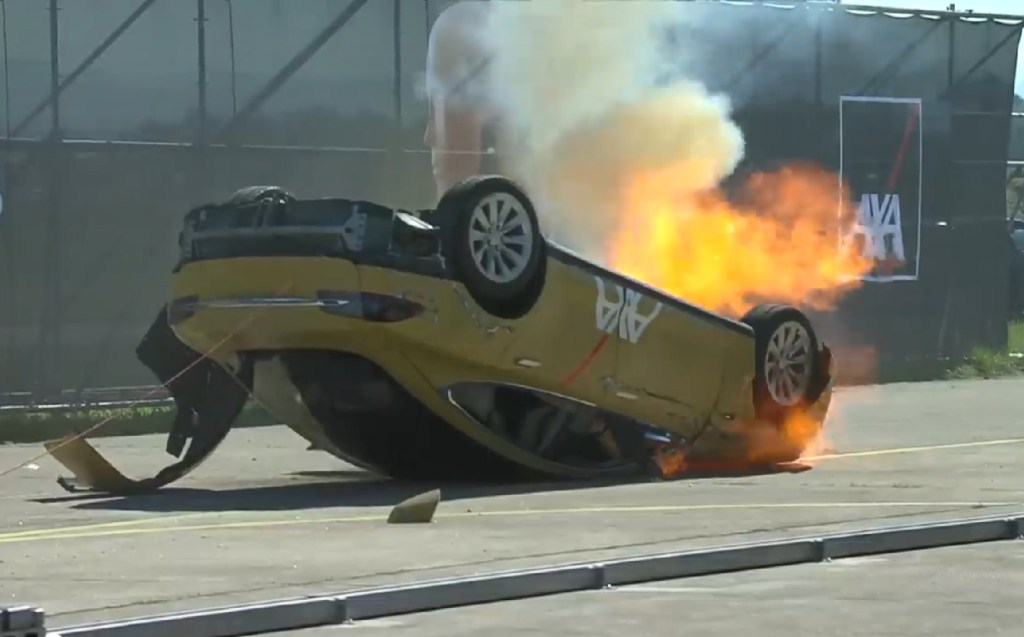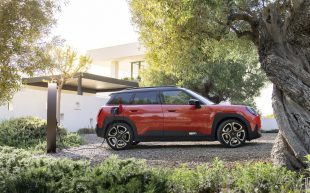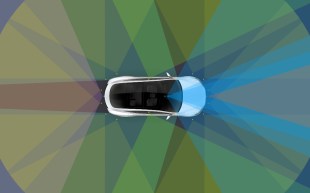Axa admits faking Tesla battery fire in crash test
Batteries not included (at all)
Insurance company Axa has apologised for creating a “false impression” after releasing a video of a crash test in which a Tesla Model S rolls over an explodes.
The video released in late August shows an older Model S leaping over several obstacles and flipping onto its roof in a simulated crash test before, seconds later, bursting into flames, necessitating the arrival of a fire engine.
Axa has subsequently admitted, however, that not only was the “fire” staged using pyrotechnics, but that the Tesla did not have its battery pack or high-voltage electrical systems onboard.

The point of the exercise, it said, was to show that an electric vehicle can easily catch fire if its undercarriage gets damaged or scraped in certain types of crash. Some of the claims it made in a press release immediately following the tests, however, were dubious at best.
Axa hypothesised that in the type of crash demonstrated by the test (i.e. the battery being impacted from below such as when vaulting over a roundabout or a large rock), the lack of protection afforded the battery represented an “Achilles heel” for EVs. Such a hypothesis isn’t especially strong, given that EV underbodies are generally well protected and fires following such rare accidents are not a common occurrence.
In that same press release, the company did concede that battery fires are extremely rare.
“Fortunately, the risk of fire in cars, regardless of whether they are petrol or electric, is low. Statistically, only five out of 10,000 cars die in a fire,” the statement, translated from German, said.
While electric vehicle fires such as those involving Teslas or the Chevrolet Bolt in the United States are, as an emerging technology, frequently reported upon, statistically, they’re uncommon.
Another crash test by Axa involving a Volkswagen e-Golf and a combustion-powered Golf also sought to demonstrate that electric vehicles are usually heavier than their petrol- or diesel-powered equivalents and thus have the potential to cause more damage to other vehicles in a crash. A fire, fake or otherwise, did not result from this test.
Not everybody was convinced by Axa’s tests and claims and the company was forced to admit that the fire had been staged following direct questions from the German website 24Auto.de.
Axa claims EV drivers cause more collisions
On September 1, the firm issued a public letter apologising for having potentially misled the public about the inherent dangers of electric vehicles and said that it believes in the future of EVs. It went on, however, to defend the test and the reasoning behind it.
“Axa Switzerland’s statistics show that drivers of electric vehicles cause 50% more collisions with damage to their own vehicles than drivers of conventional vehicles with combustion engines,” the letter read.
In its original press release following the crash test, the company had said that it believed that the reason behind the higher proportion of collisions involving electric cars was as a result of what it called the “Overtapping Effect” or drivers failing to anticipate the sudden rapid delivery of torque resulting from being unintentionally overzealous with the accelerator of an electric vehicle.
“What the statistics also show,” the company said, continuing its follow-up apology, “is that drivers of more powerful electric vehicles cause damage to either their own or someone else’s vehicle more frequently.
“Our aim with this year’s crash tests was to draw attention to these insights from our statistics and — at the same time — raise awareness of the risks that can potentially arise with accidents involving battery-powered cars.”
The company confirmed the battery was removed from the Tesla for safety reasons:
“When simulating an accident scenario where a battery-powered car catches fire, various safety precautions are taken in order to protect spectators. No battery cells were used in the test vehicle, for example, and the subsequent fire was extinguished under controlled conditions.
“In addition, the crash test with a Tesla vehicle did not cause the type of damage to the undercarriage that would be likely to spark a battery fire as the images would appear to suggest. The test that was carried out therefore did not confirm the hypothesis for this accident scenario.”
In short, the company admitted that the test showed that the Tesla would not have suffered the type of damage that could have led it to catching fire even had its battery been intact, which critics said fails to back up Axa’s initial claim about the underbody representing an Achilles heel for EVs.
It is not clear though how much differently the car would have behaved in the crash had the heavy battery pack been included.
“We should have made explicit mention of this fact in our communication measures after the test, namely in our press release and the related images that were made available.
“Axa Switzerland’s crash tests are aimed at prevention, and they are used to flag up risks that are derived from our claim statistics as Switzerland’s biggest motor vehicle insurer, as well as to anticipate and start a discussion around emerging trends and potential risks.
“They serve to highlight potential accident risks on a general, non-make and non-model-specific basis, and cannot be compared to the standardized Euro NCAP crash tests.”
Related articles
- After reading about Axa admitting to faking a Tesla battery fire, you should check out when Elon Musk offered to sell $6bn of Tesla stock if UN can prove the money could end world hunger
- Did you hear that the Tesla Model 3 was second in list of UK’s best-selling cars of 2021?
- We drove the Tesla Model Y in the UK and found its one flaw…
Latest articles
- Omoda 5 prototype review: Bargain family SUV is solid first effort for new Chinese brand
- Dacia Duster 2024 review: Rugged, affordable SUV modernised with electrification and quite the glow up
- Audi A3 Sportback 2024 review: Softly, softly, catchy premium hatchback buyer
- New electric-only Mini Aceman fills gap between Mini Cooper hatch and Countryman SUV
- Tesla driver arrested on homicide charges after killing motorcyclist while using Autopilot
- Porsche Macan 2024 review: Sporty compact SUV goes electric, but is it still the class leader for handling?
- F1 2024 calendar and race reports: What time the next grand prix starts and what happened in the previous rounds
- Aston Martin DBX SUV gets the interior — and touchscreen — it always deserved
- Nissan unveils bold look for updated Qashqai, still made in UK













